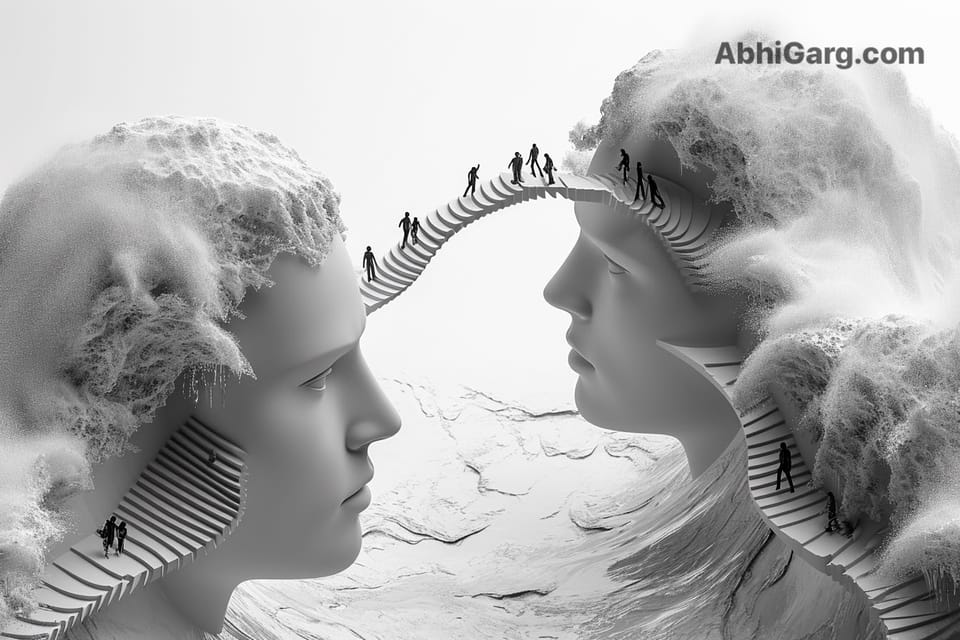Memory and Imagination: Exploring the Interplay Between Past and Future

While completing this piece, I realized the topic extends into Dreams and their analysis. Including that would have made this a very long read. Hence, I exclude explicit coverage of dreams and how memories and imagination influence our dreams.
Introduction
Our minds are remarkable instruments, capable of reliving past experiences and creating entirely new scenarios. This dual ability, embodied in the processes of memory and imagination, forms the foundation of our consciousness and shapes our understanding of the world around us. While memory allows us to learn from past experiences, imagination empowers us to envision future possibilities and solve complex problems creatively.
In this exploration, I will examine the intricate relationship between memory and imagination, examining their similarities and differences and their crucial roles in shaping our understanding of the past and future. By understanding these cognitive processes, we can gain valuable insights into how our minds work and how we can harness their power for personal growth and mental well-being.
I. Defining Memory and Imagination
Memory: The Mind's Time Machine to the Past
Memory is the cognitive process of encoding, storing, and retrieving information and experiences from the past. It serves as our archive, allowing us to recall events, facts, and emotions from our experiences. Memory is not just a passive storage system but an active process that continuously reshapes and reorganizes information based on new experiences and knowledge.
Key characteristics of memory include:
1. Encoding: The initial process of recording information in the brain.
2. Storage: The retention of encoded information over time.
3. Retrieval: The process of accessing stored information when needed.
4. Malleability: New experiences and information can influence and alter memories.
5. Associative nature: Memories are often interconnected, with one memory triggering the recall of related memories.
Imagination: The Mind's Canvas for the Future
On the other hand, imagination creates mental images, scenarios, or ideas not directly tied to current sensory input or past experiences. It allows us to transcend the boundaries of our immediate reality and explore possibilities that may not yet exist.
Key characteristics of imagination include:
1. Creativity: The ability to generate novel ideas and scenarios.
2. Flexibility: Not bound by the constraints of reality or past experiences.
3. Problem-solving: Enables us to envision solutions to complex problems.
4. Emotional simulation: Allows us to anticipate and prepare for future emotional states.
5. Goal-setting: Helps in visualizing and planning for future achievements.

II. Neurological Basis
Shared Pathways: The Brain's Multitasking Network
One of the most fascinating aspects of memory and imagination is that they utilize many of the same neurological circuits, particularly involving the hippocampus.
This shared neural architecture suggests a deep interconnection between our ability to recall past events and our capacity to envision future scenarios.
The hippocampus, a seahorse-shaped structure in the brain's temporal lobe, plays a crucial role in both processes:
1. Memory formation: The hippocampus is essential for consolidating short-term memories into long-term storage.
2. Spatial navigation: It helps create cognitive maps of our environment.
3. Imagination and future thinking: Recent studies have shown that the hippocampus is also active when we imagine future events or novel scenarios.
Other brain regions involved in both memory and imagination include:
1. The prefrontal cortex: Involved in executive functions, planning, and decision-making.
2. The posterior cingulate cortex: Associated with episodic memory retrieval and self-reflection.
3. The medial temporal lobe: Crucial for declarative memory and spatial processing.
Differences in Activation: Subtle Distinctions in Neural Patterns
While memory and imagination share neural pathways, they activate these regions in distinct ways. Neuroimaging studies have revealed subtle differences in brain activation patterns when people are engaged in remembering past events versus imagining future scenarios:
1. Temporal focus: Sensory and emotional processing regions are typically more activated when recalling memories. In contrast, imagining future events activates abstract thinking and planning areas.
2. Level of detail: Memories often involve more vivid and detailed neural representations, while imagined scenarios may be more schematic and less specific.
3. Self-referential processing: Both processes involve self-referential thinking, but imagination may engage more strongly with areas involved in prospective thinking and self-projection into the future.
These differences in neural activation patterns reflect the distinct cognitive functions of memory and imagination despite their shared neural substrates.

III. Functional Differences
Memory: Learning from the Past
The primary purpose of memory is to help us learn from past experiences and inform our present decisions and behaviors. This adaptive function allows us to:
1. Avoid repeating mistakes
2. Build on past successes
3. Recognize patterns and predict outcomes
4. Form and maintain relationships based on shared experiences
5. Develop a sense of personal identity and continuity
However, memory is constrained by what we have experienced.
It is subject to accuracy issues and potential distortions, such as:
1. Fading: Details of memories can become less clear over time.
2. Reconstruction: Each time we recall a memory, we may subtly alter it.
3. Bias: Our current emotions and beliefs can influence how we remember past events.
4. False memories: Sometimes, We can "remember" events that never happened.
Imagination: Crafting the Future
Imagination serves a different yet equally crucial function. It allows us to:
1. Plan for future events and set goals
2. Solve problems creatively by envisioning novel solutions
3. Empathize with others by imagining their perspectives
4. Prepare emotionally for potential future scenarios
5. Engage in creative expression through art, literature, and innovation
Unlike memory, imagination is not bound by past experiences.
This flexibility enables:
1. Creation of entirely new scenarios and ideas
2. Combination of elements from different experiences in novel ways
3. Exploration of hypothetical situations and their potential outcomes
4. Adaptation to new and unfamiliar situations
This freedom from the constraints of reality allows imagination to be a powerful tool for innovation and personal growth.
IV. Interdependence
Memory Influencing Imagination
While imagination allows us to create novel scenarios, it often draws on elements from our memories. This interplay manifests in several ways:
1. Building blocks: Our imagination uses fragments of memories to construct new scenarios.
2. Contextual framing: Past experiences provide a framework for imagining future events.
3. Emotional coloring: The emotions associated with our memories can influence the tone of our imagined scenarios.
4. Probability assessment: We use our memories to judge the likelihood of imagined future events.
For example, when imagining a future vacation, we might draw on memories of past trips, combining elements of different experiences to create a new scenario.
Imagination Shaping Memory
Interestingly, the relationship between memory and imagination is not one-way. Our imagination can also influence and even alter our memories:
1. False memories: Imagining events vividly can sometimes lead to the creation of false memories, where we believe we've experienced something that never actually happened.
2. Memory enhancement: Imagination can help fill in gaps in our memories, potentially making them feel more complete or vivid.
3. Reframing: Imagining alternative perspectives or outcomes can change how we remember and interpret past events.
4. Future-oriented memories: Our imagination of future events can shape how we encode and store new memories, as we may pay more attention to details relevant to our imagined future.
This bidirectional relationship highlights the dynamic nature of our cognitive processes and the complex interplay between our understanding of the past and our anticipation of the future.
Sunk Cost Fallacy
Anchoring Bias
Confirmation Bias
Fundamental Attribution Error
Endowment Effect
V. Psychological and Emotional Impact
Memory: The Emotional Time Capsule
Memory plays a crucial role in our emotional lives and psychological well-being:
1. Emotional resonance: Recalling past experiences can evoke strong emotions, influencing our mood and mental state.
2. Identity formation: Our memories form the basis of our narrative and sense of self.
3. Relationship maintenance: Shared memories help strengthen social bonds and foster a sense of belonging.
4. Learning and growth: Reflecting on past experiences can lead to personal insights and growth.
5. Trauma and healing: While traumatic memories can cause distress, processing these memories is often crucial for healing and recovery.
The emotional impact of memories can be both positive and negative. Positive memories can serve as a source of comfort and motivation, while negative memories can lead to anxiety, depression, or post-traumatic stress.
Imagination: The Emotional Simulator
Imagination also plays a significant role in our emotional and psychological functioning:
1. Emotional preparation: We can mentally prepare for potential emotional challenges by imagining future scenarios.
2. Motivation: Visualizing future success can drive us to work harder towards our goals.
3. Anxiety and worry: Imagination can sometimes lead to excessive worry about potential problems.
4. Empathy and social cognition: Imagining others' perspectives helps us emotionally understand and connect with them.
5. Creativity and self-expression: Imagination allows us to express our inner emotional world through art, writing, and other creative pursuits.
Imagining different scenarios can be a powerful tool for emotional regulation and personal growth. However, it's important to balance imaginative thinking with realistic assessment to avoid excessive anxiety or unrealistic expectations.
What is Déjà vu?
Déjà vu is a fascinating psychological phenomenon that offers intriguing insights into our memory and perception.
- Temporal lobe glitch: Déjà vu might result from a brief disruption in the temporal lobe, which processes memory formation and sensory input. This "glitch" could cause a momentary mismatch between perception and memory processing, creating the illusion of familiarity.
- Memory misfiling: One theory suggests that déjà vu occurs when our brains mistakenly "file" a new experience directly into long-term memory, bypassing short-term memory. This creates an immediate sense of familiarity with the current experience.
- Pattern recognition gone awry: Our brains are constantly seeking patterns and connections. Déjà vu might occur when our pattern recognition systems erroneously identify a situation matching a vague, forgotten memory or a general sense of familiarity.
- Parallel processing lag: Our brains process information through multiple parallel pathways. Déjà vu could result from a slight delay between these pathways, causing the same information to be processed twice rapidly, creating a sense of repetition.
- False familiarity: Déjà vu might be a form of cognitive illusion where our brains falsely signal that an experience is familiar, possibly due to subtle environmental cues we're unaware of.
- Memory consolidation echoes: Some researchers propose that déjà vu might be related to memory consolidation during sleep, where fragments of waking experiences are reactivated and might create a sense of familiarity when encountering similar contexts.
VI. Philosophical Perspectives
The relationship between memory and imagination has long been a subject of philosophical inquiry, raising profound questions about the nature of consciousness, reality, and personal identity.
Debates and Theories
1. The Simulation Theory: Some philosophers argue that memory and imagination are fundamentally the same process, with memory being a simulation of past events and imagination being a simulation of possible future events.
2. The Constructive Episodic Simulation Hypothesis: This theory suggests that episodic memory and future thinking (imagination) rely on the same core network of brain regions and cognitive processes.
3. The Reality Monitoring Framework: This perspective focuses on distinguishing between memories of actual events and imagined scenarios, suggesting that this differentiation relies on the quality and source of the mental representations.
4. The Extended Mind Thesis: Some philosophers argue that our cognitive processes, including memory and imagination, extend beyond our brains to external tools and technologies.
Self-Consciousness and Personal Identity
The interplay between memory and imagination is crucial to our sense of self and personal identity:
1. Narrative self: Our memories form the basis of our life story, while our imagination allows us to project this narrative into the future.
2. Temporal extension: Memory and imagination together allow us to experience a sense of continuity across time, from our past to our anticipated future.
3. Counterfactual thinking: Our ability to imagine alternative versions of past events or future possibilities contributes to our sense of agency and free will.
4. Self-improvement: By imagining future versions of ourselves, we can set goals and work towards personal growth.
These philosophical perspectives highlight the profound implications of memory and imagination for our understanding of consciousness, reality, and personal identity.
VII. Practical Applications
Understanding the interplay between memory and imagination has numerous practical applications in various fields:
Memory-Based Applications
1. Cognitive Behavioral Therapy (CBT): Therapists use memory recall techniques to help patients process and reframe traumatic experiences.
2. Reminiscence Therapy: This approach, often used with older adults, involves recalling positive memories to improve mood and cognitive function.
3. Mnemonic Devices: These memory aids often involve imaginative elements and can enhance learning and recall.
4. Eyewitness Testimony: Understanding the malleability of memory is crucial in legal contexts where eyewitness accounts are used.
Imagination-Based Applications
1. Guided Imagery: This therapeutic technique uses imagination to promote relaxation and healing.
2. Visualization in Sports: Athletes use mental imagery to improve performance and prepare for competitions.
3. Future Self-Interventions: Imagining one's future self can motivate better decision-making in finance and health.
4. Creative Problem-Solving: Techniques like brainstorming rely on imagination to generate novel solutions.
Integrative Approaches
1. Virtual Reality Therapy: This emerging field combines elements of memory and imagination to treat conditions like PTSD and phobias.
2. Prospective Memory Training: Techniques that combine memory and imagination can help improve our ability to remember future tasks.
3. Narrative Therapy: This approach uses storytelling, drawing on memory and imagination, to help individuals reframe their life experiences and future possibilities.
By leveraging our understanding of memory and imagination, we can develop more effective strategies for learning, problem-solving, personal growth, and mental health treatment.
Conclusion
The intricate dance between memory and imagination forms the backdrop of our conscious experience, allowing us to learn from the past and plan for the future. While these cognitive processes share neural pathways and often work together, they serve distinct yet complementary functions in our mental lives.
Memory grounds us in our personal and collective history, providing a foundation for learning and identity formation. On the other hand, imagination frees us from the constraints of the present, enabling creativity, problem-solving, and future planning.
Understanding the relationship between memory and imagination offers valuable insights into how we perceive, interpret, and interact with the world. It highlights the dynamic nature of our mental processes and the remarkable plasticity of our brains.
In embracing both the reliability of our memories and the creativity of our imagination, we can strike a balance that allows us to learn from our experiences while remaining open to new possibilities. This balance is key to personal growth, innovation, and our ability to adapt to an ever-changing world.




